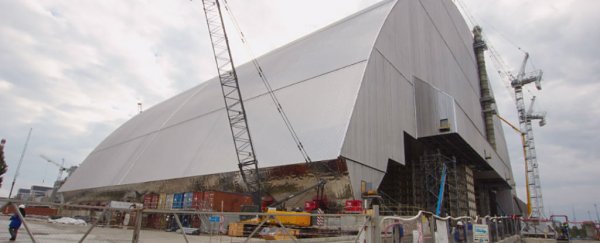It's been three decades since the Chernobyl nuclear disaster devastated Ukraine and surrounding areas, but the locals are still dealing with the consequences today, with roughly 2,600 square kilometres (1,000 square miles) of land surrounding the failed plant considered unsuitable for humans.
At the time, locals scrambled to contain the failed reactor in a gigantic concrete dome, but recent fears that it's now leaking radioactive material - and could be close to collapse - has prompted the construction of an even bigger metal 'sarcophagus' to hide it all away.
This colossal radiation shield, called the New Safe Confinement, measures 275 metres (900 feet) wide and 108 metres (354 feet) tall, and cost US$1.6 billion to construct.
Because the scene of the catastrophic meltdown at Chernobyl's number four reactor is still far too dangerous for anyone to approach - the radioactive release was 10 times bigger than the nuclear bomb on Hiroshima - the shield had to be constructed nearby, and it's now being slowly inched into place.
The whole thing weighs a whopping 36,000 tonnes, which is equivalent to about 100 jumbo jets, and it's being manoeuvred to the reactor using an extensive system of hydraulic jacks.
Experts expect that it will reach its final destination by November 29.
"The start of the sliding of the arch over Reactor 4 at the Chernobyl nuclear power plant is the beginning of the end of a 30-year long fight with the consequences of the 1986 accident," Ukraine's Environment Minister Ostap Semerak told the press this week.
Staff from the European Bank for Reconstruction and Development (ERBD) - the group responsible for building the steel and concrete sarcophagus - claim it's the largest moveable land-based structure ever built.
"[It's] one of the most ambitious projects in the history of engineering," the ERBD said of the construction and repositioning of the dome.
The coolest part about the giant structure isn't that it's expected to contain the radioactive for at least the next 100 years, it's that robotic appendages have been installed in the roof, so once everything is in place, they can start dismantling the most dangerous parts of the building from within.
Here's what the construction looked like:

Even if the shield is successful at keeping what remains in the reactor from getting out into the atmosphere, at this stage, there's little hope that the vast exclusion zone will ever be suitable for humans to repopulate.
While wildlife populations appear to be thriving in the radiation-stricken ghost town, milk produced on the border - some thousands of kilometres away from the site of the meltdown - still contains 10 times the accepted radiation limits, even 30 years after the event.
But just because the land isn't suited to humans doesn't mean it's not suited for other things.
Back in July, the Ukrainian government announced a plan to turn the area surrounding Chernobyl into a massive solar energy farm, which would not only decrease the country's reliance on Russia for its power, but would also create a whole new industry while the panels are being installed.
"The Chernobyl site has really good potential for renewable energy," said Ukraine's environment minister, Ostap Semerak.
"We already have high-voltage transmission lines that were previously used for the nuclear stations, the land is very cheap, and we have many people trained to work at power plants."
With a massive radiation dome and solar panels galore, things might finally be looking up for Chernobyl.
Here's what it looks like today:

Facebook image: Diana Markosian/Wikimedia
